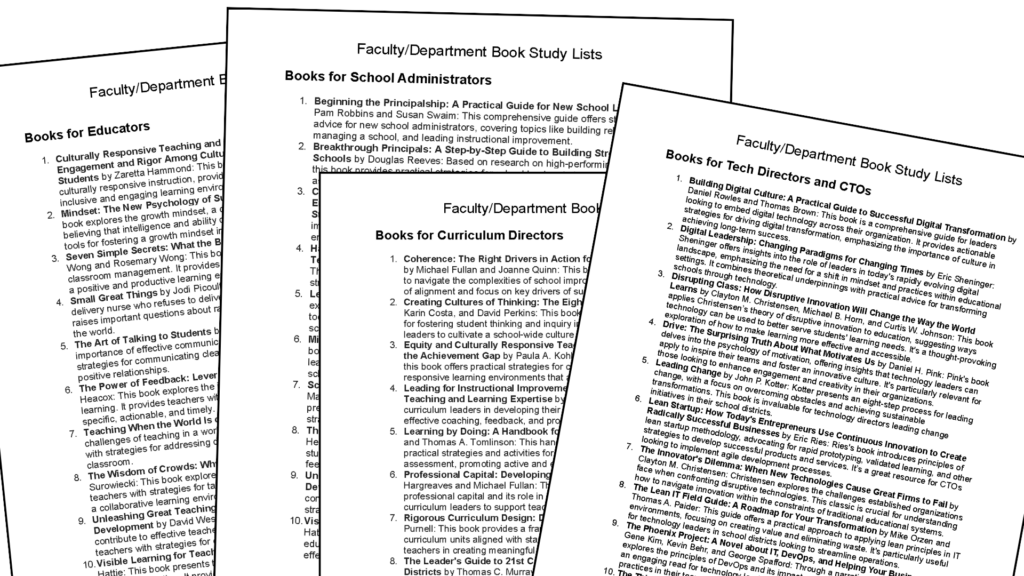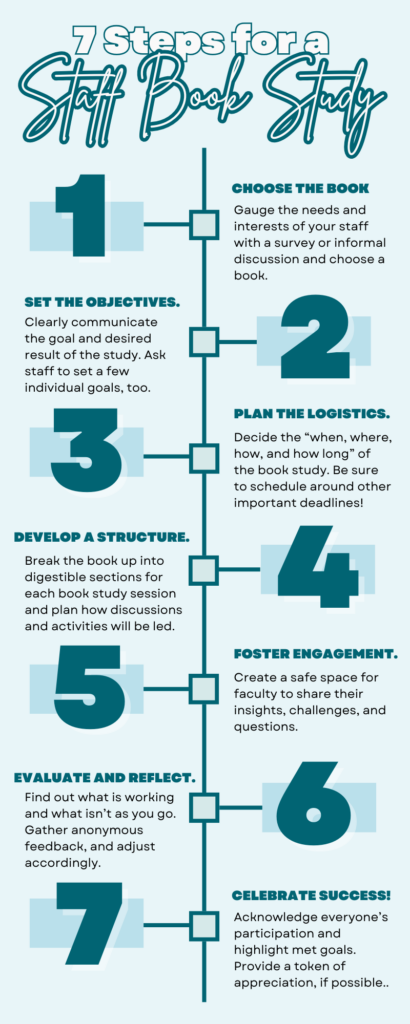If you are like me, faculty or department meetings don’t top your list of fun activities. They may be necessary, but this doesn’t mean they always feel relevant. If that describes your faculty or department meetings, consider organizing and leading a book study. Below, I’ll give you a step-by-step guide to having a successful book study with your team. You’ll also find a variety of books to consider! Let’s explore this method of professional development where everyone reads the same book but may have different takeaways, thoughts, and perceptions.
Step 1: Choose the right book.
Choosing the right book is critical to the success of the book study. If no one is interested in what they’re reading, no one will want to participate. Start by gauging the interests and needs of your staff. A short survey or informal discussion can help identify common interests and areas your staff would like to improve. Be sure that your book is relevant to your staff’s daily responsibilities and the broader goals of your school/district. And make sure the book is readily available for everyone. Consider if there’s a need for digital copies or audiobooks for accessibility.
Check out our lists of recommendations, or ask a local school librarian for assistance in compiling a list of possible titles.
Step 2: Set clear objectives.
Before the book study begins, clearly communicate the goals of the study. They could range from enhancing teaching strategies and integrating new technology to fostering a more inclusive classroom environment. Allow flexibility for each person to tailor the goals to their specific roles. Avoid a one-size-fits-all approach by ensuring the objectives align with the professional development needs of the faculty. While you may have a group goal, ask each person to consider identifying one or two individual goals for personal application and growth. Also, determine if participation is optional. If not, how will you be compensating your staff for reading? Will they have time during the work day, or is this considered an “all other duties as assigned” task?
Step 3: Plan the logistics.
Decide on a timeline and make your plans. Here are a few questions to consider when planning:
- How long will the book study last?
- When and how often will meetings occur?
- Will the meetings be in-person, online, or a hybrid?
- What is the size of the group?
Consider what works best for the majority. Also, consider the group size. Smaller groups often encourage more participation. Try breaking it into smaller discussion groups if you have a larger group. Additionally, be aware of major tasks and deadlines required of your team. Account for times of higher stress and workload when planning the timeline of your book study; you may need to include ‘intermissions’ to allow time for major projects, like state testing, grade reporting periods, holiday breaks, etc.
Step 4: Develop a structure.
Develop a book study structure that makes sense for the chosen book. Break the book into manageable sections for each session. That may be chapters, or it might be clusters of chapters. Consider a distributed leader model where the discussion leaders rotate. This can keep engagement high and allow different perspectives to lead the conversation. But be sure to communicate this beforehand so the leaders are prepared. Include activities that enhance understanding of the material, such as role-playing, debates, or scenarios. If you are unsure what activities to include, consider asking ChatGPT or Gemini for ideas. Be sure to specify the book title, author, and chapter in your prompt. We all know that “turn and talks” and other activities can become annoying when overused, so try varying the strategies and activities to target a variety of learning and communication styles.
Step 5: Foster engagement and participation.
Create a safe space for faculty to share their insights, challenges, and questions. This may be best done by allowing others in the group to lead different meetings. Your group may also benefit from times when you are not there, so they have less pressure to talk and “say the right thing.” Encourage participants to share how they can apply or how they’ve already used what they’ve learned in their work. Consider ways to gently ensure that participants keep up with the readings and actively engage in discussions. While you may be meeting in the larger group setting most of the time, consider having several sessions where your staff are meeting in smaller groups for a more focused discussion. This could be by grade level, content area, job role, department, etc.
Step 6: Evaluate and reflect.
Don’t wait until the end of the book study to ask for feedback or ways to improve. Like formative assessment in the classroom, find out what is working and what isn’t. Then, be prepared to adjust, as needed, to make the study more effective. At the end, collect anonymous feedback on what worked well and what could be improved on for future sessions. After some time has passed, evaluate the impact of the book study on professional practices and the learning environment. This could be done through surveys, interviews, or an informal discussion.
Step 7: Celebrate achievements!
Acknowledge everyone’s participation and highlight any significant changes or achievements resulting from the book study. Ask your staff to highlight each other’s accomplishments and give shout-outs on how others supported their growth. Encourage staff to share their learning with peers who might not have participated in the book study. And, if possible, provide a token of appreciation to those who participated. This could come through a community donor or a local business willing to support your staff in furthering their growth in the district.
Book Recommendations
While we provided several book recommendation lists to consider, we would love to hear from you! What book do you think would make for a great book study? Jump into the comment section and tell us the book title, author(s), and audience for the book study.



